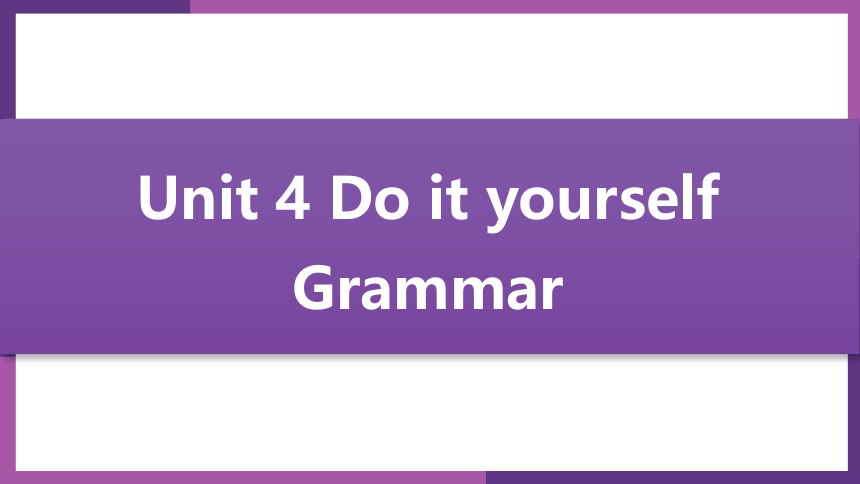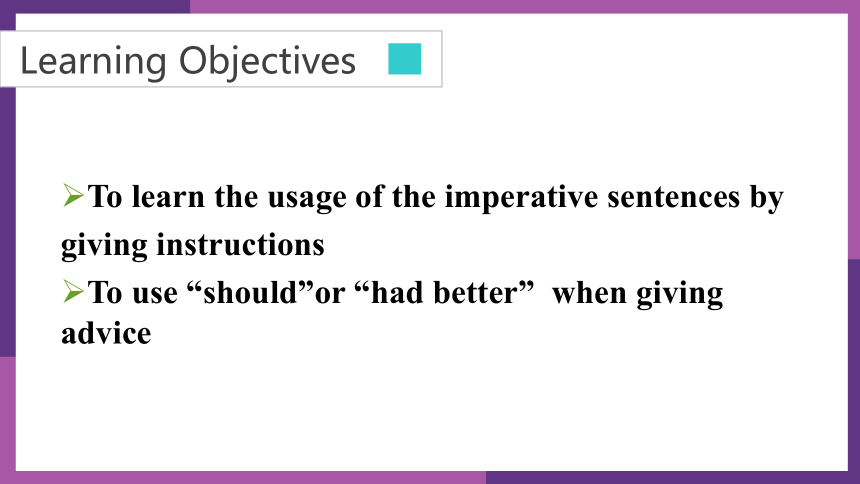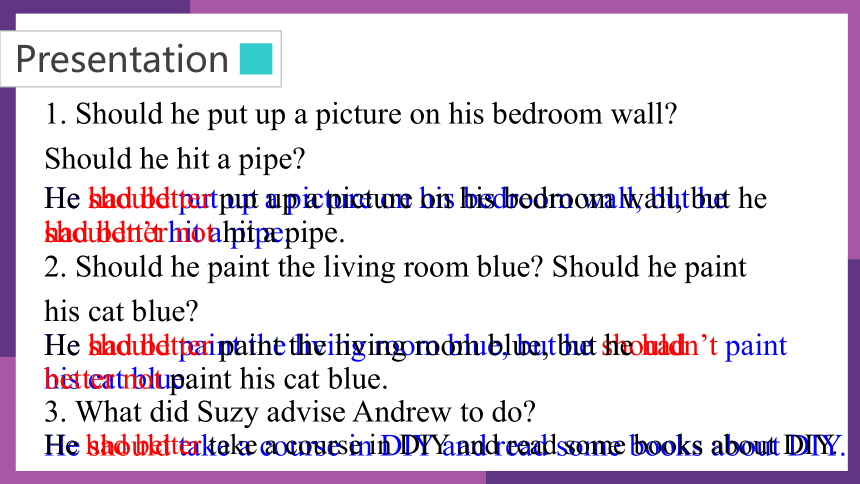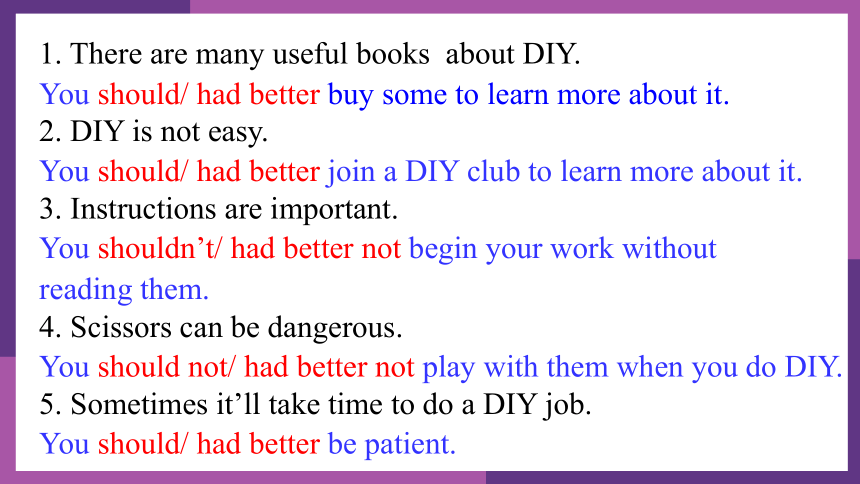牛津译林版英语八年级上册同步课件Unit 4 period 4 Grammar(18张)
文档属性
| 名称 | 牛津译林版英语八年级上册同步课件Unit 4 period 4 Grammar(18张) |  | |
| 格式 | zip | ||
| 文件大小 | 1.1MB | ||
| 资源类型 | 教案 | ||
| 版本资源 | 牛津译林版 | ||
| 科目 | 英语 | ||
| 更新时间 | 2022-06-06 11:31:03 | ||
图片预览







文档简介
(共18张PPT)
Unit 4 Do it yourself
Grammar
To learn the usage of the imperative sentences by
giving instructions
To use “should”or “had better” when giving advice
Learning Objectives
Presentation
1. Should he put up a picture on his bedroom wall
Should he hit a pipe
2. Should he paint the living room blue Should he paint
his cat blue
3. What did Suzy advise Andrew to do
He should put up a picture on his bedroom wall, but he shouldn’t hit a pipe.
He should paint the living room blue, but he shouldn’t paint his cat blue.
He should take a course in DIY and read some books about DIY.
He had better put up a picture on his bedroom wall, but he had better not hit a pipe.
He had better paint the living room blue, but he had better not paint his cat blue.
He had better take a course in DIY and read some books about DIY.
We use should and had better when giving advice!
You should/ had better….
You shouldn’t/ had better not…
The tone of had better is stronger than should!
How to obey the school rules
We should/had better wear school uniforms.
We should/had better be friendly to others.
We shouldn’t/had better not ride bikes in the school.
We shouldn’t/had better not be late for school.
……
Discussion
B
Suzy is giving DIY advice to her classmates. Read the advice below. Help Suzy make sentences with should (not) or had better (not).
a begin your work without reading them
b join a DIY club to learn more about it
c be patient
d buy some to learn more about it
e play with them when you do DIY jobs
Practice
1. There are many useful books about DIY.
You should/ had better buy some to learn more about it.
2. DIY is not easy.
3. Instructions are important.
4. Scissors can be dangerous.
5. Sometimes it’ll take time to do a DIY job.
You should/ had better join a DIY club to learn more about it.
You shouldn’t/ had better not begin your work without
reading them.
You should not/ had better not play with them when you do DIY.
You should/ had better be patient.
Extension
Say our daily life
…should…
…shouldn’t…
…had better…
…had better not….
Discussion
Be a better man!
Don't be a rude man!
Giving instructions!
Presentation
Giving instructions!
*Stand up!
*Turn left!
*Turn off the lights!
*Don’t be afraid!
*Don’t move!
*Write the word “instruction” on the blackboard!
肯定形式
否定形式
Presentation
Giving instructions!
祈使句
祈使句,无主语,只用动词原形就可以.
表示请求或命令,加上please表客气。
如果变成否定句, Don’t开头是规律。
Conclude and learn the rules
1) 祈使句的肯定结构 (动词原形开头,句末感叹号!)
① Do型 Sit down!? Stand up!?Listen carefully.
② Be型(以be开头) Be quiet!?安静! Be careful!小心!
③ Let型(let sb do sth) Let me try. 让我试试看。
Let’s look at the map. 让我们看看地图。
2) 祈使句的否定结构,在肯定结构前加 Do not (Don’t)。
Don’t go there, please. 请别去那儿。
Don’t be late for class! 上课别迟到!
Don’t let him in. 不要让他进来。
3)表示请求、劝告的祈使句还常常在句前或句末加上please, 构成句式:Please …或 …, please. 以使语气更加缓和或客气。
Please have a rest.
Have a rest, please. 请休息一下。
A
Complete the instructions.
_____out pieces of card with a pair of scissors.
______ some words or a sentence on each card.
_______ a picture about the words or sentence on the other side of the card.
Cut
Draw
Write
cut draw give keep look try write
_____ at the picture and ___ to remember
what is on the other side.
Look
try
Please _________ (not) up. ______ trying, and you will find you can remember things better.
don’t give
Keep
( )1. —Jim, _____ read books while you are walking in the
street.
It’s very dangerous. — OK, thank you.
A. don’t B. doesn’t C. won’t D. can’t
( )2. —______ up, Anna. It’s seven thirty.
—One more minute, Mum.
A. Get B. Gets C. Getting D. Got
Exercise
A
A
( )3. Jim, _____ me a hand.
A. gives B. is giving C. will give D. give
( )4. ____ careful, Jenny! There is a tree in front of you.
A. Am B. / C. Be D. Was
( )5. Let's ____ our time.
A. not waste B. no wasting
C. not to waste D. no waste
D
C
A
GOOD JOB
Unit 4 Do it yourself
Grammar
To learn the usage of the imperative sentences by
giving instructions
To use “should”or “had better” when giving advice
Learning Objectives
Presentation
1. Should he put up a picture on his bedroom wall
Should he hit a pipe
2. Should he paint the living room blue Should he paint
his cat blue
3. What did Suzy advise Andrew to do
He should put up a picture on his bedroom wall, but he shouldn’t hit a pipe.
He should paint the living room blue, but he shouldn’t paint his cat blue.
He should take a course in DIY and read some books about DIY.
He had better put up a picture on his bedroom wall, but he had better not hit a pipe.
He had better paint the living room blue, but he had better not paint his cat blue.
He had better take a course in DIY and read some books about DIY.
We use should and had better when giving advice!
You should/ had better….
You shouldn’t/ had better not…
The tone of had better is stronger than should!
How to obey the school rules
We should/had better wear school uniforms.
We should/had better be friendly to others.
We shouldn’t/had better not ride bikes in the school.
We shouldn’t/had better not be late for school.
……
Discussion
B
Suzy is giving DIY advice to her classmates. Read the advice below. Help Suzy make sentences with should (not) or had better (not).
a begin your work without reading them
b join a DIY club to learn more about it
c be patient
d buy some to learn more about it
e play with them when you do DIY jobs
Practice
1. There are many useful books about DIY.
You should/ had better buy some to learn more about it.
2. DIY is not easy.
3. Instructions are important.
4. Scissors can be dangerous.
5. Sometimes it’ll take time to do a DIY job.
You should/ had better join a DIY club to learn more about it.
You shouldn’t/ had better not begin your work without
reading them.
You should not/ had better not play with them when you do DIY.
You should/ had better be patient.
Extension
Say our daily life
…should…
…shouldn’t…
…had better…
…had better not….
Discussion
Be a better man!
Don't be a rude man!
Giving instructions!
Presentation
Giving instructions!
*Stand up!
*Turn left!
*Turn off the lights!
*Don’t be afraid!
*Don’t move!
*Write the word “instruction” on the blackboard!
肯定形式
否定形式
Presentation
Giving instructions!
祈使句
祈使句,无主语,只用动词原形就可以.
表示请求或命令,加上please表客气。
如果变成否定句, Don’t开头是规律。
Conclude and learn the rules
1) 祈使句的肯定结构 (动词原形开头,句末感叹号!)
① Do型 Sit down!? Stand up!?Listen carefully.
② Be型(以be开头) Be quiet!?安静! Be careful!小心!
③ Let型(let sb do sth) Let me try. 让我试试看。
Let’s look at the map. 让我们看看地图。
2) 祈使句的否定结构,在肯定结构前加 Do not (Don’t)。
Don’t go there, please. 请别去那儿。
Don’t be late for class! 上课别迟到!
Don’t let him in. 不要让他进来。
3)表示请求、劝告的祈使句还常常在句前或句末加上please, 构成句式:Please …或 …, please. 以使语气更加缓和或客气。
Please have a rest.
Have a rest, please. 请休息一下。
A
Complete the instructions.
_____out pieces of card with a pair of scissors.
______ some words or a sentence on each card.
_______ a picture about the words or sentence on the other side of the card.
Cut
Draw
Write
cut draw give keep look try write
_____ at the picture and ___ to remember
what is on the other side.
Look
try
Please _________ (not) up. ______ trying, and you will find you can remember things better.
don’t give
Keep
( )1. —Jim, _____ read books while you are walking in the
street.
It’s very dangerous. — OK, thank you.
A. don’t B. doesn’t C. won’t D. can’t
( )2. —______ up, Anna. It’s seven thirty.
—One more minute, Mum.
A. Get B. Gets C. Getting D. Got
Exercise
A
A
( )3. Jim, _____ me a hand.
A. gives B. is giving C. will give D. give
( )4. ____ careful, Jenny! There is a tree in front of you.
A. Am B. / C. Be D. Was
( )5. Let's ____ our time.
A. not waste B. no wasting
C. not to waste D. no waste
D
C
A
GOOD JOB
